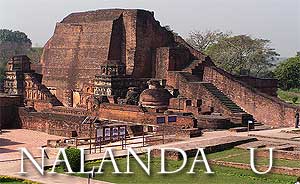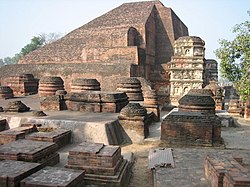Harsha, ruled from 606-647 AD, over an empire in northern India.
Harsha was perhaps one of the greatest conquerors of Indian history, and unlike all of his conquering predecessors, he was a brilliant administrator.
He was also a great patron of culture. His capital city, Kanauj, extended for four or five miles along the Ganges River and was filled with magnificent buildings. Only one fourth of the taxes he collected went to administration of the government. The remainder went to charity, rewards, and especially to culture: art, literature, music, and religion.
The most significant achievements of this period, however, were in religion, education, mathematics, art, and Sanskrit literature and drama.
The religion that later developed into modern Hinduism witnessed a crystallization of its components: major sectarian deities, image worship, bhakti (devotion), and the importance of the temple. Education included grammar, composition, logic, metaphysics, mathematics, medicine, and astronomy. These subjects became highly specialized and reached an advanced level.
Harshavardhana.

Nalanda University

 Nalanda was one of the world's first residential and most famous universities, i.e., it had dormitories for students. In its heyday, it accommodated over 10,000 students and 2,000 teachers.
Chinese pilgrims estimated the students between 3,000 and 5,000.
The university was considered an architectural masterpiece, and was marked by a lofty wall and one gate. Nalanda had eight separate compounds and ten temples, along with many other meditation halls and classrooms. On the grounds were lakes and parks.
The library was located in a nine storied building where meticulous copies of texts were produced. The subjects taught at Nalanda University covered every field of learning, and it attracted pupils and scholars from Korea, Japan, China, Tibet, Indonesia, Persia and Turkey.
The library at Nalanda University was an immense complex.
The exact number of volumes of the Nalanda University Library is not known but it is estimated to have been in the hundreds of thousands. The library not only collected religious manuscripts but also had texts on such subjects as grammar, logic, literature, astrology, astronomy, and medicine
The library was destroyed in 1197–1203 during the Muslim invasion in which Bakhtiyar Khalji sacked it and set it to flames. The library burnt for several days with black clouds hovering over.
Nalanda was one of the world's first residential and most famous universities, i.e., it had dormitories for students. In its heyday, it accommodated over 10,000 students and 2,000 teachers.
Chinese pilgrims estimated the students between 3,000 and 5,000.
The university was considered an architectural masterpiece, and was marked by a lofty wall and one gate. Nalanda had eight separate compounds and ten temples, along with many other meditation halls and classrooms. On the grounds were lakes and parks.
The library was located in a nine storied building where meticulous copies of texts were produced. The subjects taught at Nalanda University covered every field of learning, and it attracted pupils and scholars from Korea, Japan, China, Tibet, Indonesia, Persia and Turkey.
The library at Nalanda University was an immense complex.
The exact number of volumes of the Nalanda University Library is not known but it is estimated to have been in the hundreds of thousands. The library not only collected religious manuscripts but also had texts on such subjects as grammar, logic, literature, astrology, astronomy, and medicine
The library was destroyed in 1197–1203 during the Muslim invasion in which Bakhtiyar Khalji sacked it and set it to flames. The library burnt for several days with black clouds hovering over.
Harsha, ruled from 606-647 AD, over an empire in northern India.
Harsha was perhaps one of the greatest conquerors of Indian history, and unlike all of his conquering predecessors, he was a brilliant administrator.
He was also a great patron of culture. His capital city, Kanauj, extended for four or five miles along the Ganges River and was filled with magnificent buildings. Only one fourth of the taxes he collected went to administration of the government. The remainder went to charity, rewards, and especially to culture: art, literature, music, and religion.
The most significant achievements of this period, however, were in religion, education, mathematics, art, and Sanskrit literature and drama.
The religion that later developed into modern Hinduism witnessed a crystallization of its components: major sectarian deities, image worship, bhakti (devotion), and the importance of the temple. Education included grammar, composition, logic, metaphysics, mathematics, medicine, and astronomy. These subjects became highly specialized and reached an advanced level.
Harshavardhana.

Nalanda University

 Nalanda was one of the world's first residential and most famous universities, i.e., it had dormitories for students. In its heyday, it accommodated over 10,000 students and 2,000 teachers.
Chinese pilgrims estimated the students between 3,000 and 5,000.
The university was considered an architectural masterpiece, and was marked by a lofty wall and one gate. Nalanda had eight separate compounds and ten temples, along with many other meditation halls and classrooms. On the grounds were lakes and parks.
The library was located in a nine storied building where meticulous copies of texts were produced. The subjects taught at Nalanda University covered every field of learning, and it attracted pupils and scholars from Korea, Japan, China, Tibet, Indonesia, Persia and Turkey.
The library at Nalanda University was an immense complex.
The exact number of volumes of the Nalanda University Library is not known but it is estimated to have been in the hundreds of thousands. The library not only collected religious manuscripts but also had texts on such subjects as grammar, logic, literature, astrology, astronomy, and medicine
The library was destroyed in 1197–1203 during the Muslim invasion in which Bakhtiyar Khalji sacked it and set it to flames. The library burnt for several days with black clouds hovering over.
Nalanda was one of the world's first residential and most famous universities, i.e., it had dormitories for students. In its heyday, it accommodated over 10,000 students and 2,000 teachers.
Chinese pilgrims estimated the students between 3,000 and 5,000.
The university was considered an architectural masterpiece, and was marked by a lofty wall and one gate. Nalanda had eight separate compounds and ten temples, along with many other meditation halls and classrooms. On the grounds were lakes and parks.
The library was located in a nine storied building where meticulous copies of texts were produced. The subjects taught at Nalanda University covered every field of learning, and it attracted pupils and scholars from Korea, Japan, China, Tibet, Indonesia, Persia and Turkey.
The library at Nalanda University was an immense complex.
The exact number of volumes of the Nalanda University Library is not known but it is estimated to have been in the hundreds of thousands. The library not only collected religious manuscripts but also had texts on such subjects as grammar, logic, literature, astrology, astronomy, and medicine
The library was destroyed in 1197–1203 during the Muslim invasion in which Bakhtiyar Khalji sacked it and set it to flames. The library burnt for several days with black clouds hovering over.



